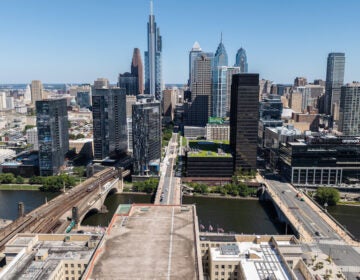PBS film crew visits Venturi house in Chestnut Hill
Emmy-winning Chicago-based writer, TV host and historian Geoffrey Baer is intrigued by the tempest that erupted when Philadelphia-born architect Robert Venturi built a rather unusual house in Chestnut Hill for his mother, Vanna Venturi, in the 1960’s.
A calculated rejection of the popular principles of modernist architecture (whose geometrical glass and steel boxes took hold in America in the mid-twentieth century), the Vanna Venturi House (also known in architectural circles as “Mother’s House”) ignited a massive controversy.
“You would’ve thought that we were being invaded by a life-threatening enemy,” Baer says of the “vitriol” of Venturi’s detractors at the time. “It’s this little house in Chestnut Hill!”
When they arrived at the famous site near Pastorious Park in late April, NewsWorks caught up with Baer and the film crew of WTTW Chicago, producer of a new PBS documentary about America’s most influential architecture. The film will air nationwide in approximately one year.
“Not all of these buildings were the first of their kind,” Baer says, explaining that as writer and host of the program, he chose the buildings to be featured along with the show’s producers and a large panel of architectural experts. “But they were important in defining where architecture went.”
“10 Buildings That Changed America” will feature structures from Thomas Jefferson’s 1788 Virginia State Capitol to world-renowned contemporary architect Frank Gehry’s 2003 Walt Disney Concert Hall in Los Angeles (filming began two weeks ago when Baer interviewed Gehry there).
The Virginia Capitol is important because it established the American tradition of modeling public buildings on Greek and Roman temples, breaking with Europe’s traditional Georgian edifices. The program will also include Frank Lloyd Wright’s 1910 Robie House in Chicago (“of course we couldn’t do this without Wright,” Baer says), Albert Kahn’s 1920 Ford Plant in Highland Park, Michigan, and Minnesota’s 1956 Southdale Center by Victor Gruen, recognized as America’s first indoor shopping mall.
“From a small spark, a great forest fire began,” Baer says of the Venturi house and the influence it had on a generation of post-modern architects, who flouted the streamlined, industrialized abstractions of modernism in favor of a return to more evocative, historically-inspired forms.
Venturi, born in Philadelphia in 1925, made a habit of disobeying his professors. The initial plans for the controversial house, completed in 1964, had many incarnations, all revolving around an outsized fireplace and chimney as an overarching symbol of the concept of hearth and home.
The 1800-square-foot home is not very large (it’s the smallest of the buildings featured in the documentary), but many architectural scholars note that there is a grand scale to its construction. In fact, the longer one looks at the house, the more its apparent simplicities begin to contradict each other. Its pronounced chimney and deceptively simple triangular façade evoke the archetypal house of a child’s drawing, yet on second look its angles are full of subtle challenges to its apparent symmetry.
Inside, its narrow stairways wrap tortuously around the fireplace and chimney – a struggle as well as a kind of structural embrace that emphasizes the importance of the hearth. Critics devoted to the prevailing modernist style – which Baer describes as an effort to “throw away all our messy history” – denigrated the house’s overt symbolism and the obvious classical allusions in its shapes and arches.
Now, though Venturi decries much of the contemporary architecture his work inspired, the fact remains that his 1964 house was the vanguard of the postmodern movement in the field, and Mother’s House went on to become a seminal lesson for architecture students across the country, inspiring a multitude of books.
“I saw the house on slides in a lecture before I ever saw it myself,” says current resident Agatha Hughes, whose parents purchased the house from Venturi in the 1970s, while she was a college student in Texas. Many people don’t realize that the famous little building is still a private residence, and Venturi devotees on the lawn are a frequent hazard of living there.
Hughes provides insight to the updates on the house’s external appearance. When first completed, it was a shade of green – apparently because a professor of Venturi’s counseled him never to paint a house green. The exterior paint was re-done several times over the years, faithful to the original shade, but about six years ago, with Venturi’s own agreement that “the house was showing its age,” Hughes, Venturi and an extended impromptu jury of neighbors and committee members deliberated on what the new color should be.
Several shades of gray were selected and judiciously applied in large samples. Venturi visited at 7 a.m. and at 4 p.m. for days, to consider the color both in full sun and with the sun behind the house. Finally, everyone agreed on a shade and the painting commenced.
When it was half-finished, Hughes remembers, one day Venturi “came flying down the driveway at 90 mph.” He had found the perfect color – a light gray – and everyone immediately agreed he was right.
“It’s my favorite color of all the years,” Hughes now says of the shade Venturi discovered at the last minute.
Baer is looking forward to capturing the house’s story and monumental aesthetic for his viewers. “It’s been like a feast, a dream project,” he says of making “10 Buildings”. In the end, he hopes the program, aimed at those without expertise in architecture, will illuminate the heart of this most practical art form.
“What messages do buildings send?” he asks. “What are the architects trying to say?” Is there something inherently American about the way architecture has evolved here over the last two hundred years? “It’s great to get inside the minds of the people who conceived these buildings.”
WHYY is your source for fact-based, in-depth journalism and information. As a nonprofit organization, we rely on financial support from readers like you. Please give today.








